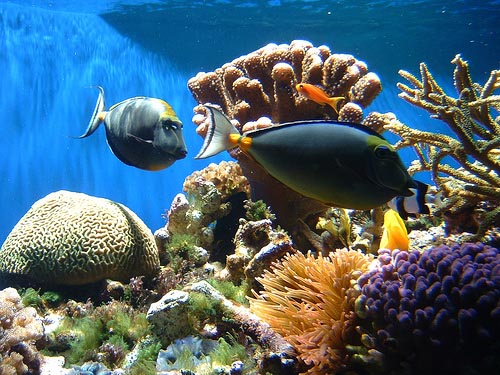NOAA (National Ocean and Atmospheric Administration) warns: Virginia island coral reefs again in danger of extinction.
ST. CROIX, Virginia Islands (August 23, 2006) - Scientists with the National Ocean and the Atmospheric Administration have issued a warning to scuba divers and fishermen, to see if there are any signs of coral damage, as temperatures in the Caribbean were much higher than usual this week.
Als Strongs, a scientist at the NOAA Coral Reef Observatory, found that sea surface temperatures in Puerto Rico and Virginia on Tuesday islands has reached 83.66 degrees Fahrenheit or 28.7 degrees Celsius, beating the peak that usually occurs in September and October.
"We have found temperatures that are above normal throughout the year," Strong said on Wednesday, with predictions that temperatures are already above normal. "
Strongs concluded by saying that above-normal temperatures signaled last year's devastating coral spoilage, which killed 40 percent of coral reefs in the entire area. '' Be that as it may, he said, scientists will continue to check sea temperatures for the next 30 days. '' If water temperatures continue to rise, scientists fear coral reefs could suffer even more damage.
NOAA (National Ocean and Atmospheric Administration) calls on scuba divers and underwater researchers to be vigilant and look for coral damage in the area, as well as to be careful near reefs, which are very vulnerable to physical contact.
U.S. Geological Survey biologist Erinna Millere, who works with the National Park Service in St. John's, said satellite imagery is very important because it keeps researchers on course.
While NOAA satellites monitor surface temperatures, Miller Authority and the Park Service measure below the surface temperature of the observation site around St. John's and St. Croix.
"Temperature gauges will give water much more accurate and reliable measurements on site," Miller said.
She said the measurements of the underwater gauges were made in late July and the temperature in Virginia Island waters has reached 29 degrees Celsius.
"As the water is known to be warm and getting warmer usually during the summer months," said Miller, "we can't predict now whether it will be the same as last year."
Last year, on eight major reefs, in St. John's and St. Croix, the Park Service observed damage caused by overheated water. Biologists became cautiously optimistic when heavy rains were reduced in October oceantemperature region and showed signs of recovery from whitening.
But a few weeks later, when the corals regained their color, death "patches" began to appear. Officials said the disease, possibly unique to the region, had destroyed nearly 40 percent of corals at Park Service sites in just ten months.
Miller said biologists would monitor coral reefs and sea temperatures in the coming weeks. She said the recent subdued skies, heavy rainfall and windy conditions have lowered the high temperatures below the surface and they hope that such conditions will continue.
Miller said as long as coral species acclimatize to warmer temperatures, half a degree could change a lot.
High sea temperatures expose corals under stress, making fragile submarine life more susceptible to disease and premature death. Living under the sea for life, coral reefs are a safe place to feed and breed fish, lobsters and other animals.
News source - Virgin Islands Daily News


